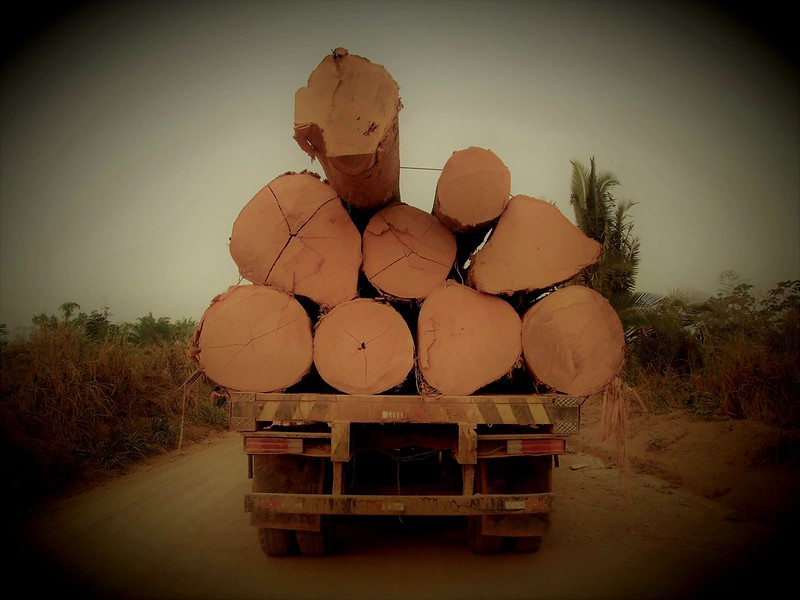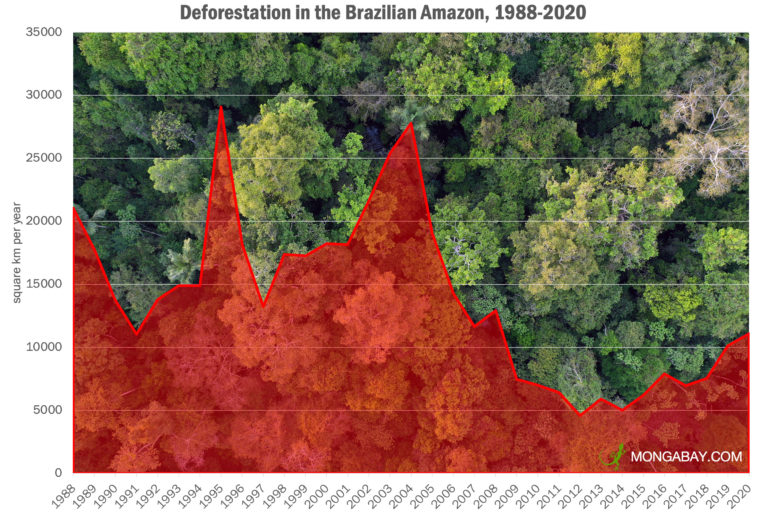- Relentless deforestation has pushed the Amazon to the brink of an ecological shift from rainforest to savannah with potentially devastating consequences for climate change and biodiversity.
- Home to most of the world’s tropical forest land, almost all logging in the Amazon is thought to be illegal, yet few penalties are imposed on offenders.
- To address the culture of impunity, a new data visualization platform, Ecocrime, has been developed by the Igarapé Institute, which seeks to expose the organized criminal networks that sustain illicit trade in the Amazon.
Mongabay caught up with Igarapé Institute co-founder Robert Muggah this week to discuss Ecocrime, a new data visualization platform that combines visual storytelling with access to raw data on environmental crime in the Amazon.
This interview has been edited for style and clarity.
Mongabay: What prompted you to create the platform?
Robert Muggah: The Amazon is facing a catastrophic tipping point. Levels of deforestation and degradation – most of it illegal – are accelerating. Global attention to it is episodic at best. The COVID-19 crisis has reduced visibility of the issue, especially as governments, business and civil societies are preoccupied with their own challenges. The Igarape Institute is determined to ensure there is a more regular drumbeat of information available about the range of environmental crimes that are being committed in the region. With more transparency, we hope to strengthen accountability and action to pull the Amazon back from the brink.
There are still tremendous knowledge gaps when it comes to environmental crime in the Amazon. Many governments, businesses and advocacy groups are focused on just one part of a very complex problem. Understanding the ways in which different types of crimes – land grabbing, illegal logging, wildcat mining, the wildlife trade – and the networks that sustain them is a first step. Recognizing the different types of illegalities occurring at every stage of the criminal supply chain is no less important. The Institute has drawn on a combination of remote sensing tools and investigative research to help present data in an accessible format to reduce these information asymmetries.

Addressing environment crime is about enforcing the rule of law. Right now, well over 95% of all deforestation is illegal. Less than 5% of people convicted of environmental crime end up paying any fines. The only way to sustainably address these challenges is by ensuring there is a lawful green economy, one that places a higher value on conservation and protection than on extraction and exploitation. The good news is that there are many incredible international, national and hyper-local initiatives underway to provide solutions. We hope to strengthen their efforts and safety by exposing the dark underside of what’s happening in the Amazon.
How do you envisage a typical user interacting with EcoCrime?
It is critical that mapping tools such as EcoCrime provide an immersive and accessible experience when it comes to data on environmental crime. It is not enough just to layer fields on a map. Often, decision-makers, journalists and advocates do not know exactly what they are looking for or how best to interpret findings. The Institute has considerable experience developing data visualization platforms – from mapping homicide and city fragility around the world to predicting crime at the city scale. In this case, the Institute worked to provide a highly accessible and curated experience, bringing raw data and human stories to the forefront.

The platform has two basic functions. The first consists of the actual data which features open source information on specific types of environmental crime. The second includes short stories that provide short summaries of specific types of crime that are present on the map. The goal is to provide users with a short ‘guided tour’ before they dive into the maps. The Igarape Institute will be uploading new data fields regularly. What’s more, short stories will be changing every month, with users invited to submit examples from their experience that will be vetted by the Igarape Institute. Additional stories will be supplied by core partners such as InSight Crime and Interpol, among others.
Did you face any hurdles in accessing, cleaning, or presenting the data from so many disparate sources?
There is a fair amount of heterogeneity when it comes to data on environmental crimes in the Amazon Basin. Some of the datasets had to be created from scratch while others are developed by leading research institutes. There are nevertheless very real gaps, not least because the issue has not been at the forefront of the climate action agenda. In all cases, however, data requires some time to clean and standardize. The Institute has a data science team that is expert in vetting and rendering information on geospatial layers.

After a round of consultations with prospective users, the Institute detected a very strong demand for a centralized data visualization platform. For example, law-enforcement agencies are desperate for more systematic datasets and analysis of key trends. Environmental and indigenous activists groups are keen to have a centralized data repository for advocacy and research purposes. Governments and businesses are also calling for data to inform decisions on everything from regulatory policy to impact investment. The Institute has formed a partnership with Brazil’s public prosecutors to also test their data. Over time, we hope to build out a leading ‘one-stop-shop’ as a public good.
What plans do you have to add to the data used on the platform?
The current version of Ecocrime, with its focus on providing timely high-resolution data on among other things, forest fires, wildcat mining, and attacks on environmental defenders, is just the beginning. We are working with partners in the law enforcement, climate action and investigative journalism spaces to populate the platform with many more data fields over the coming year. We’ll be visualizing criminal networks that sustain environmental crime across all eight countries in the Amazon Basin. We’re also working with partners to map out other types of ancillary crime, including drug production, wildlife trafficking and child slavery, among ther categories.

One area the Institute hopes to make real strides is in relation to high-resolution geospatial analytics. At the moment, we’re using conventional map-based software. The Institute is exploring a deeper partnership with Planet, a satellite-based earth observation company, to take our maps to the next level. Likewise, the Institute is reviewing possibilities to undertake more advanced analytics, including forecasting and predictive mapping, based on historical trends. Our goal is to become a primary source of reliable, verified and action-oriented data for disrupting environmental crime across the region.
Have you faced any opposition?
Not yet. That said, there are many people benefiting from environmental crime, and as they become more exposed, we expect resistance. The political economy of land grabbing, cattle washing and illegal mining is hugely complex and multiple players are involved. There are big investors in global cities, contractors who supply equipment, regulators and licensing officers, export and import authorities, and of course individuals involved directly in extracting resources and protecting their assets. The more their activities are exposed, the more opposition we can expect.

Ultimately, what role do you hope Ecocrime can play in addressing the lack of accountability regarding environmental crime in the Amazon?
The first step to solving any complex problem such as rampant deforestation of the Amazon is understanding what it is and what’s driving it. This is first a conceptual challenge, which is why the Institute worked with partners to develop a typology of environmental crime. The second step is mapping out the scope, scale and dimensions of the problem, which is where data-driven maps come in. A third step is to ensure that relevant analysis is effectively communicated to the right audiences, from decision-makers and opinion-shapers to environmental and indigenous defenders on the frontlines. The Ecocrime platform is itself part of a much wider ecosystem focused on protecting the Amazon and the roughly 30 million people who depend on it for survival.
The Igarape Institute is working with a broad constellation of partners to draw attention to environmental crime and mobilize pinprick interventions to disrupt it. The data platform is used to help get allies literally and figuratively on the same page. The Institute is working with governments on strengthening regional cooperation to prevent environmental crime at source. The Institute’s partnered with international organizations to track criminality across global supply chains, including illicit financing. The Institute is supporting non-governmental and grassroots organizations, helping build local capacity to capture and communicate data. Finally, the Institute is working with private sector actors – traders, investors, and retailers – to enhance compliance with respect to social impact. It is only through impact-oriented partnerships that we’ll change the game.
Banner image: IBAMA agents on a raid against illegal loggers in Jamanxim National forest, Pará state, Brazil. Image courtesy of IBAMA.














